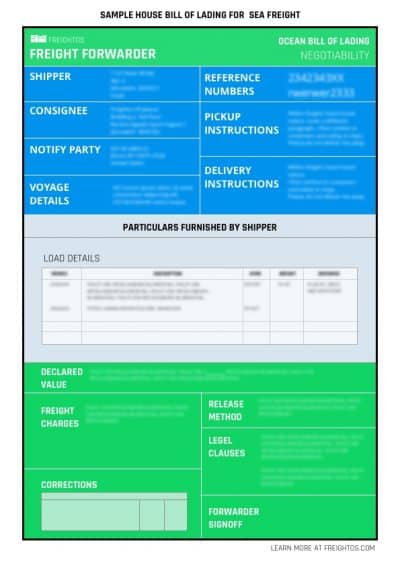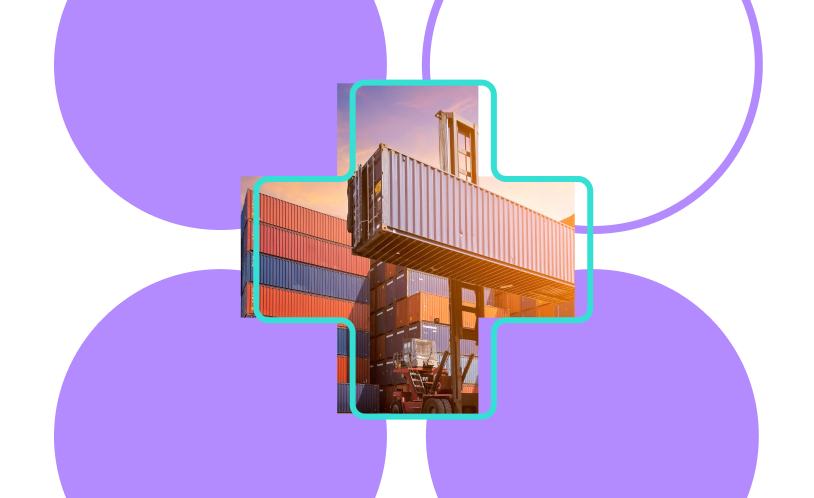Part of the Key Freight Documents Guide.
Ocean freight is a trillion dollar business that hinges on buyers getting goods and sellers getting paid.
That mostly comes down to one incredibly important freight document – the Bill of Lading (BOL, B/L, BL, Sea Waybill).
In this article, we will explore what a BOL is, how to fill one out, and the different types you might encounter.
What is a Bill of Lading?
A Bill of Lading is really three documents rolled into one:
1. The Bill of Lading is a Loading Receipt
The word “lading” is an archaic form of “loading”. Blackbeard would have used it when piling more booty onto his pirate ship.
The bill of lading started out as a receipt issued when a shipment was loaded onto a vessel (not that Blackbeard was too fussed about paperwork).
It is still used as a receipt at pickup, handed to the seller as proof that the goods were handed over. It is also a receipt that the shipment was handed over in good condition unless a note to the contrary is made on the BOL at pickup.
2. The Bill of Lading is a Contract of Carriage
The second role a bill of lading plays is as a shipment contract. The terms and conditions of the forwarder arranging the international transit are included on the bill of lading.
Technically, the contract begins when you accept the forwarder’s freight quote but the Contract of Carriage is evidence of that contract, otherwise, why is the shipment being picked up for international transit?
Forwarder terms and conditions are usually written on the reverse side. And it turns out that forwarders (carriers too, for that matter) limit their liability for the shipment if something goes wrong.
That’s why taking out comprehensive cargo insurance is so important.
3. The Bill of Lading is a Document of Title
The third role a BOL plays is as proof of ownership. Technically, the commercial invoice does that.
The buyer and seller select freight terms (Incoterms) when putting the deal together. The Incoterm listed on the commercial invoice sets the point during transit when the goods change hands.
Possession is nine-tenths of the law, and possessing the bill of lading has come to be used as proof of ownership. The seller gets it in their hands at pickup. Later on, the buyer will need it for shipment release.
The BOL is Useful in Other Ways, Too
- Tracking: If the master bill of lading number (more on that later) is recorded on the BOL, it can also be used for shipment tracking. Other tracking identifiers, like container numbers, are often recorded on the BOL.
- Payment: The bill of lading is one of the key documents submitted in the Letter of Credit (L/C) process.
- Insurance claims: The BOL must be submitted when filing a claim for lost or damaged cargo.
- Insurance liability: If a bill of lading has been issued in a freight forwarder’s name, they can be liable for damage to freight – even if they don’t handle it.
What is Included on a Bill of Lading Form?
Forwarders create their own forms, each with their own design.
Fortunately, they all essentially have the same information and in roughly in the same place on the form, as laid out in this conceptual design.

The following tables explain each of the sections in more detail.
Or skip to:
Shipment Details | Load Details | Contract Details
Bill of Lading: Shipment Details
| SHIPMENT DETAILS | |
| Shipper | Name and contact details of the seller (factory owner or supplier), unless an L/C specifies otherwise. |
| Consignee | Name and contact details of the buyer, unless an L/C specifies otherwise. This field can be used to specify negotiability:If “to order (of) …” comes before the consignee’s name, the shipment is negotiable by endorsement.If the field is left blank or states “Bearer”, the shipment is negotiable even without an endorsement. |
| Notify Party | Name and contact details of any other party that should be notified, such as the destination customs broker or third party warehouse. |
| Voyage Details | The port to port ocean leg.Carrier booking details, e.g. carrier name, vessel number, voyage number, and ports of loading/departure and discharge/entry.Place of receipt by the carrier, ie, the port where the shipment is handed over to the carrier.Place of delivery by carrier, ie, the port where the carrier hands over the shipment. |
| Pickup Instructions | Place of the pickup, including country of origin.Forwarding agent contacts and references.Carrier pre-carriage (rail/barge) details – if applicable.Consolidation center details. |
| Delivery Instructions | Point of final delivery for the goods.Delivery agent details.Consolidation center details. |
| Reference Numbers | Forwarder’s reference (house BOL) number.Carrier booking number and/or master BOL number.Other reference numbers, e.g. export references. |
Bill of Lading: Load Details
| THE LOAD | |
| Load Details | These usually sprawl over several columns in the central section of the form.Markings made on the packages for identification (e.g purchase number).Number of packages by type, e.g. 3 pallets.A general description of the goods (may require an attachment sheet).Weights and measurements.Product disclosure for customs, e.g. “contains no solid wood material”Other pertinent information, e.g. hazmat status, product information for Customs, container number. |
| Declared Value | Space for the shipper to write the declared value.Clause limiting carrier liability based on declared value. |
Bill of Lading: Contractual Details
| CONTRACTUAL INFORMATION | |
| Freight Charges | A handful of countries require freight charges to be recorded on the BOL.Freight payable according to the incoterm, e.g. “port of load (prepaid)” for FOB.Freight payable sometimes appears near Delivery Instructions. |
| Corrections | Amendments made to the BOL, e.g. changes to weight and dimensions made by the port authority after VGM weighing. |
| Release method | Release details often appears elsewhere on the form, e.g. at the top, or stamped over the load details table. Count of originals often appears in the Legal Clauses section.The BOL format the buyer must use when receiving the shipment, either:express release: emailed pdf.originals required: physically possession of hard copy form.Using originals is slower and more expensive, but is still preferred when paying by L/C – with the bank only triggering payment when all originals have been delivered. Sometimes, payment occurs before delivery. If the shipper notifies the forwarder, the release of goods can occur without originals. This hybrid method is called telex release. |
| Legal clauses | Clause for shipper (Loading Receipt).Clause for consolidation liability (either shipper or forwarder).Clause that forwarder’s standard T&Cs apply or reference to full T&Cs “on the back”. May also include a summary of terms. |
| Forwarder Sign-off | Place of Issue, Date of Issue, and Signature. |
| Forwarder | Specified at the top of the form. Logo, name, and sometimes contact details. |
| Negotiability | Usually specified at the top of the form, and/or in the consignee field. Most BOLs are marked negotiable, meaning the goods can change ownership while in transit. Only large companies shipping in-house or between sister companies should mark the shipment as non-negotiable. |
The Bill of Lading described here is the contract of carriage between the forwarder and their customer. It is more properly called the House BOL, to distinguish it from a very similar document called the Master BOL.
Both BOLs are created for each international shipment, but the Master Bill of Lading is the contract of carriage between the forwarder and the carrier.
Incidentally, most information online is about the Master, not the House, document.
The Master Bill of Lading also acts as the forwarder’s receipt of delivery and contract of carriage. The end customer doesn’t get a copy of this document, but their forwarder should provide them with the Master Bill of Lading number. It acts as a tracking number while the shipment is in the carrier’s hands.
You will first see the House BOL as a draft. Soon after reserving a carrier booking, the forwarder will send a draft to confirm weights and dimensions. It is important to check them because the departure port will weigh the shipment and any discrepancy may lead to fines being imposed and the BOL being updated.
As well as checking weights and dimensions, the customer should also carefully check that all other information is correct. Even minor discrepancies between the House BOL and the commercial invoice or shipping records could trigger costly customs inspections later on.
When using original copy release, be careful not to lose your copy. It’s much more tortuous than the forwarder simply writing out and sending a replacement.
There’s more than importers could learn about the Ocean Bill of Lading, for instance, how a Trucking Bill of Lading or Air Waybill is different again.
Bill of Lading Types
In addition to the BOL discussed above, there are five more types you may encounter:
1. Onboard Bill of Lading
The Onboard BOL is the receipt given by the carrier when the shipment has been physically loaded onto a container ship (for ocean freight) or airplane (for air freight). If the carrier determines that the goods are not in good condition when they are received, then they will add a clause. The bill of lading is then referred to as a foul or claused bill of lading. The carrier may also note on the bill of lading that the shipment was received in good condition (Clean BOL).
2. Order Bill of Lading
An Order BOL refers to the scenario where delivery is dependent on the seller being paid. This makes the bill of lading a powerful tool, that, when endorsed, acts as collateral or can be traded as a security.
3. Received-for-Shipment Bill of Lading
When endorsed by the carrier as having been received for loading, the bill of lading acts as a receipt for the freight forwarder that they have delivered the goods. It is not proof that the shipment has been loaded on board.
4. Sea Waybill
The Sea Waybill is a simplified version of a House BOL, except it doesn’t act as a document of title. That leads to smoother shipping and, because of that, it is gaining in popularity.
5. Straight Bill of Lading
A Straight BOL refers to the scenario where the seller has already been paid and the carrier can deliver the shipment “straight” to the consignee.
Other Key Documents
Shipping Quote | Commercial Invoice | Certificate of Origin | Material Safety Data Sheet | Shipper’s Letter of Instruction | Booking Confirmation | Packing List | Letter of Credit



